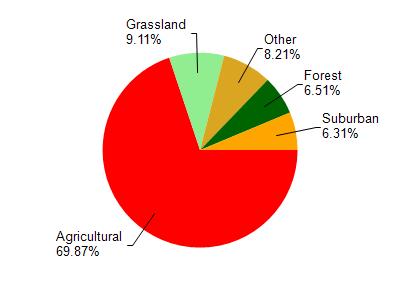Rock
No
Yes
No
Fish and Aquatic Life
Overview
Spring Brook (T2N R14E S22) This four-mile-long spring and seepage creek rises in eastern Rock County 1.5 miles west of the Rock-Walworth county line and flows southerly and at a medium gradient through the Carver-Roehl County Park to its confluence with Turtle Creek. High fecal Streptococcus bacteria counts have been detected in the stream, probably due to the obvious streambank pasturing upstream in the flat terrain of the creek's headwaters adjacent to dairy farm operations. A habitat evaluation in 1996 at the Carver-Roehl Park characterized the stream as having “good” habitat quality at that site.
Rock River Water Quality Management Plan, Lower Rock River Appendix. WT-668-2002. South Central Region, WDNR.
Date 2002
Author Aquatic Biologist
Historical Description
A spring and seepage fed stream tributary to Turtle Creek. The flow
is greatly reduced in dry years. The fishery is composed of forage species only. There are 8 acres of adjoining fresh meadow wetland. Access is available from a small county park and two bridge crossings.
Surface Acres = 4.2, Miles = 3.8, Gradient = 21 feet per mile.
From: Ball, Joseph R., and Ronald J. Poff, Lake and Stream Classification Project. Surface Water Resources of Rock County, Department of Natural Resources, 1970.
Date 2011
Author Aquatic Biologist
Impaired Waters
The 2018 assessments of Spring Brook (WBIC 791300) showed impairment by phosphorus; new total phosphorus sample data exceeded the 2018 WisCALM listing criteria for the Fish and Aquatic Life use. However, no biological data (i.e. no macroinvertebrate or fish Index of Biotic Integrity (IBI) scores) were available to assess biological impairment. Based on the most updated information, this water was proposed for the impaired waters list.
Date 2017
Author Ashley Beranek
Condition
Wisconsin has over 84,000 miles of streams, 15,000 lakes and milllions of acres of wetlands. Assessing the condition of this vast amount of water is challenging. The state's water monitoring program uses a media-based, cross-program approach to analyze water condition. An updated monitoring strategy (2015-2020) is now available. Compliance with Clean Water Act fishable, swimmable standards are located in the Executive Summary of Water Condition in 2018. See also the 'monitoring and projects' tab.
Reports
Recommendations
Citizen-Based Stream Monitoring
SCR_12_CMP12 - Rock County CBSM nutrient monitoring project with WDNR.
Management Goals
Wisconsin's Water Quality Standards provide qualitative and quantitative goals for waters that are protective of Fishable, Swimmable conditions [Learn more]. Waters that do not meet water quality standards are considered impaired and restoration actions are planned and carried out until the water is once again fishable and swimmable
Management goals can include creation or implementation of a Total Maximum Daily Load analysis, a Nine Key Element Plan, or other restoration work, education and outreach and more. If specific recommendations exist for this water, they will be displayed below online.
Monitoring
Monitoring the condition of a river, stream, or lake includes gathering physical, chemical, biological, and habitat data. Comprehensive studies often gather all these parameters in great detail, while lighter assessment events will involve sampling physical, chemical and biological data such as macroinvertebrates. Aquatic macroinvertebrates and fish communities integrate watershed or catchment condition, providing great insight into overall ecosystem health. Chemical and habitat parameters tell researchers more about human induced problems including contaminated runoff, point source dischargers, or habitat issues that foster or limit the potential of aquatic communities to thrive in a given area. Wisconsin's Water Monitoring Strategy was recenty updated.
Grants and Management Projects
Monitoring Projects
| WBIC | Official Waterbody Name | Station ID | Station Name | Earliest Fieldwork Date | Latest Fieldwork Date | View Station | View Data |
|---|
| 791300 | Spring Brook | 10016796 | Spring Brook Creek - 5 M Downstream Of Bradford Clintontown Line Rd Crossing | 5/16/1997 | 4/10/2024 | Map | Data |
|

Watershed Characteristics
Spring Brook is located in the Turtle Creek watershed which is 288.47 mi². Land use in the watershed is primarily agricultural (69.80%), grassland (9.10%) and a mix of forest (6.50%) and other uses (14.50%). This watershed has 339.80 stream miles, 590.58 lake acres and 6,590.97 wetland acres.
Nonpoint Source Characteristics
This watershed is ranked Not Available for runoff impacts on streams, Not Available for runoff impacts on lakes and High for runoff impacts on groundwater and therefore has an overall rank of High. This value can be used in ranking the watershed or individual waterbodies for grant funding under state and county programs.However, all waters are affected by diffuse pollutant sources regardless of initial water quality. Applications for specific runoff projects under state or county grant programs may be pursued. For more information, go to surface water program grants.